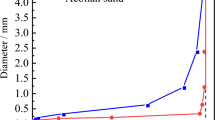Abstract
In this study, aeolian sand (AS) was substituted as a fine aggregate instead of river sand, and aeolian sand concrete (ASC) samples with different mixing content ratios (0%, 25%, 50%, 75%, 100%) were prepared. The failure law of the freeze–thaw damage in sodium chloride solution (3.5% NaCl) was then explored. X-ray diffraction (XRD), scanning electron microscopy (SEM), nuclear magnetic resonance (NMR), and a bubble spacing analyzer were used to evaluate the damage mechanism and microstructural change characteristics of the ASC samples under the conditions of salt-freezing. The results indicated that the relative dynamic elastic modulus (RDEM) could more accurately characterize the damage degree of the ASC undergoing salt-freezing effects compared with the mass loss rate. Additionally, there were many closed holes observed in the 100% ASC, which had helped to delay the freeze–thaw damage in the concrete specimens. A fractal model of the void distributions, based on the number and sizes of the voids in the ASC under salt-freezing conditions, was established in this study. The fitting correlation coefficient was greater than 0.9. It was found that the model had the ability to better predict the internal void characteristics of the concrete.








Similar content being viewed by others
References
G. Li, X. Shen, Q. Yuan, Y. Zou, and L. Xiong, JOM 71, 984 (2019).
H. Xue, X. Shen, Q. Liu, R. Wang, and Z. Liu, J. Adv. Concr. Technol. 15, 724 (2017).
G. Maria and L. Susana, Constr. Build. Mater. 73, 728 (2014).
J. Wu and X. Shen, Chin. Soc. Agric. Eng. 33, 184 (2017).
W. Dong, X. Shen, H. Xue, J. He, and Y. Liu, Constr. Build. Mater. 123, 792 (2016).
Y. Zou, X. Shen, G. Li, H. Xue, Q. Yuan, and L. Xiong, Chin. J. Build. Mater. 21, 817 (2018).
H. Xue, X. Shen, C. Zou, Q. Liu, and Y. Zou, Chin. J. Build. Mater. 22, 199 (2019).
Y. Li, H. Zhang, S. Chen, H. Wang, and G. Liu, Constr. Build. Mater. 340, 127433 (2022).
Y. Li, H. Zhang, G. Liu, D. Hu, and X. Ma, Constr. Build. Mater. 247, 118538 (2020).
X. Shen, Y. Zou, H. Xue, and G. Li, Chin. Soc. Agric. Eng. 35, 161 (2019).
W. Zhang, M. Zheng, L. Zhu, and Y. Lv, Constr. Build. Mater. 349, 128814 (2022).
Y. Zou, X. Shen, X. Zuo, H. Xue, and G. Li, Eur. J. Environ. Civ. En. 26, 1707712 (2020).
Y. Yao, C. Liu, H. Liu, W. Zhang, and T. Hu, Constr. Build. Mater. 388, 131718 (2023).
S. Yang, M. Han, X. Chen, J. Song, and J. Yang, J. Cold. Reg. Eng. 37, 1 (2023).
D. Chen, Y. Deng, J. Shen, G. Sun, and J. Shi, Constr. Build. Mater. 304, 124617 (2021).
M. Frias, S. Goñi, R. García, and R. Vigil, Compos. 46, 173 (2013).
M.W. Tjaronge and U.R. Irfan, Procedia. Eng. 125, 832 (2015).
Z. Shi, Z. Shui, Q. Li, and H. Geng, Constr. Build. Mater. 74, 57 (2015).
G. Li and X. Shen, JOM 71, 1962 (2019).
Q. Xiao, Q. Li, Y. Cao, and W. Tian, Constr. Build. Mater. 200, 66 (2019).
W. Bai, Z. Song, C. Yuan, J. Guang, C. Xie, H. Huang, and Y. Ma, Constr. Build. Mater. 375, 130872 (2023).
C. Chen, K. Zhang, Z. Yin, and J. Zhou, Buildings 13, 3 (2023).
X. Wang, X. Shen, H. Wang, and G. Chu, J. Ceram. Soc. Jpn. 123, 43 (2015).
K. Zhou, J. Li, Y. Xu, and Y. Zhang, Chin. J. Cent. South. Univ. Sci. Technol. 43, 4796 (2012).
J. Bai, Y. Zhao, J. Shi, and X. He, Constr. Build. Mater. 327, 126885 (2022).
J. Bai, Y. Zhao, J. Shi, and X. He, KSCE J. Civil Eng. 25, 12205 (2021).
J. Guo, W. Sun, Y. Xu, W. Lin, and W. Jing, Buildings 12, 1317 (2022).
S. Zhang, B. Tian, B. Chen, X. Lu, B. Xiong, and N. Shuang, Materials 15, 6215 (2022).
R. Xie, J. Yang, and E. Xie, Sci. Rep. 12, 22612 (2022).
P. Choi, J. Yeon, and K. Yun, Cem. Concr. Compos. 70, 69 (2016).
N. Mayercsik, M. Vandamme, and K. Kurtis, Cem. Concr. Res. 88, 43 (2016).
Acknowledgments
This study was supported by the National Natural Science Foundation of China under Grant (52268044, 52168033), Natural Science Foundation of Inner Mongolia Autonomous Region (2021LHMS05019), Basic scientific research business expenses of universities directly under Inner Mongolia Autonomous Region (2023QNJS161), Kundulun District Science and Technology Plan Project (YF2022012), and an Open fund project of the Institute of Building Science, Inner Mongolia University of science and technology (JYSJJ-2021Q01).
Funding
National Natural Science Foundation of China under Grant, 52268044, Dong Wei, Natural Science Foundation of Inner Mongolia Autonomous Region, 2021LHMS05019, Dong Wei, Institute of Building Science, Inner Mongolia University of science and technology, JYSJJ-2021Q01, Dong Wei, National Natural Science Foundation of China, 52168033, Dong Wei, Baotou Science and Technology Bureau, YF2022012, Dong Wei, Research Program of Science and Technology at Universities of Inner Mongolia Autonomous Region, 2023QNJS161, Dong Wei.
Author information
Authors and Affiliations
Corresponding author
Ethics declarations
Conflict of interest
The authors declare that they have no conflict of interest.
Additional information
Publisher's Note
Springer Nature remains neutral with regard to jurisdictional claims in published maps and institutional affiliations.
Rights and permissions
Springer Nature or its licensor (e.g. a society or other partner) holds exclusive rights to this article under a publishing agreement with the author(s) or other rightsholder(s); author self-archiving of the accepted manuscript version of this article is solely governed by the terms of such publishing agreement and applicable law.
About this article
Cite this article
Dong, W., Zhou, M. A Study of the Damage Mechanism and Microstructures of Aeolian Sand Concrete Specimens Undergoing Salt-Freezing Effects. JOM 75, 5290–5299 (2023). https://doi.org/10.1007/s11837-023-06153-2
Received:
Accepted:
Published:
Issue Date:
DOI: https://doi.org/10.1007/s11837-023-06153-2




